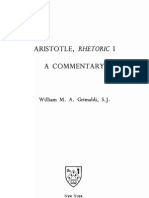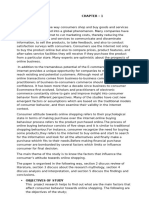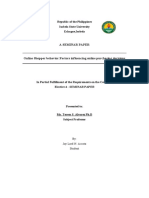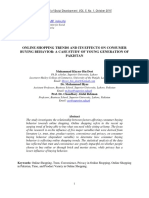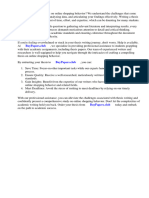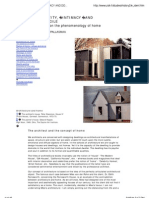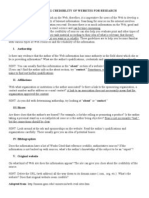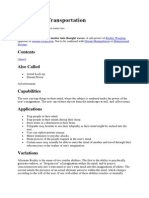0 ratings0% found this document useful (0 votes)
101 viewsReview of Literature - Karish Ma
Review of Literature - Karish Ma
Uploaded by
Lovely JeevaThis document reviews 15 studies related to online consumer behavior and multi-channel retailing. Several key findings are discussed, including that assessing consumer online shopping behavior can help retailers better understand customers, and that retailers must take an integrated approach across store and online channels to exploit growth. Privacy, security, and a preference for physical stores were found to be barriers to online shopping in some studies.
Copyright:
© All Rights Reserved
Available Formats
Download as PDF, TXT or read online from Scribd
Review of Literature - Karish Ma
Review of Literature - Karish Ma
Uploaded by
Lovely Jeeva0 ratings0% found this document useful (0 votes)
101 views12 pagesThis document reviews 15 studies related to online consumer behavior and multi-channel retailing. Several key findings are discussed, including that assessing consumer online shopping behavior can help retailers better understand customers, and that retailers must take an integrated approach across store and online channels to exploit growth. Privacy, security, and a preference for physical stores were found to be barriers to online shopping in some studies.
Original Description:
review
Original Title
Review of Literature - karish ma
Copyright
© © All Rights Reserved
Available Formats
PDF, TXT or read online from Scribd
Share this document
Did you find this document useful?
Is this content inappropriate?
This document reviews 15 studies related to online consumer behavior and multi-channel retailing. Several key findings are discussed, including that assessing consumer online shopping behavior can help retailers better understand customers, and that retailers must take an integrated approach across store and online channels to exploit growth. Privacy, security, and a preference for physical stores were found to be barriers to online shopping in some studies.
Copyright:
© All Rights Reserved
Available Formats
Download as PDF, TXT or read online from Scribd
Download as pdf or txt
0 ratings0% found this document useful (0 votes)
101 views12 pagesReview of Literature - Karish Ma
Review of Literature - Karish Ma
Uploaded by
Lovely JeevaThis document reviews 15 studies related to online consumer behavior and multi-channel retailing. Several key findings are discussed, including that assessing consumer online shopping behavior can help retailers better understand customers, and that retailers must take an integrated approach across store and online channels to exploit growth. Privacy, security, and a preference for physical stores were found to be barriers to online shopping in some studies.
Copyright:
© All Rights Reserved
Available Formats
Download as PDF, TXT or read online from Scribd
Download as pdf or txt
You are on page 1of 12
Review of Literature
1. Ankur Kumar Rastogi (2010) conducted the study on ―a
study on Indian online consumers and their buying behaviour
and the study attempts to analyze the features related to the
buying behaviour of online shoppers. Consumer buying
behaviour in respect of online shopping was studied using
different socio-economic variables. It also provides a support
that helps researchers understand the drivers of consumers‘
attitude and goal to shop on the Internet, and consumers‘
perceptions regarding ease of use and usefulness.
Conclusions derived from the analysis can be used as useful
guide for market orientation. The outcomes of the study
suggest that assessment of consumer buying behaviour can
contribute to a better understanding of consumer buying
behaviour in respect of online shopping.
2. Grashaw(2010) in his paper revealed that adopting Internet
as an additional channel for offering products is not an easy
decision for traditional brick-and-mortar retailers because it
faces the challenge of store sales cannibalization.
3. Lobaugh (2010) conducted the study an executive remarked:
―The idea that storeonly sales will decrease as multi-channel
sales increase, scares me. Our store based costs seem to
increase at a constant rate; if that is out of line with our
growth, or how customers behave, I‘m not sure of the impact.
The result will be an imbalance in our investment model.‖
According to the same report, organizations continue to think
that the purpose of multi-channel retailing is to drive traffic
into the store and not away from it. This is because many
stakeholders are anxious about rationalizing the prior and
substantial investments in real estate needed for the brick and
mortar business.
4. Zhang et al. (2010) conducted the study and found that
retailers are now realizing the need to have an integrated
approach towards store and online channels to exploit the
growth potential of multi-channel retail.
5. Demery (2010) reports, the advantage of the online channel
is that some customers find it convenient, think that it saves
their time, and observe that it is easier to find a particular
item in online store. Ruchi Nayyar (2010) in the study of
website factors on online shopping buying behaviour and the
study found that online shoppers perceive different factors
such as website design, fulfillment/reliability,
privacy/security and customer service affecting online
purchase activity differently.
6. Ruchi Nayyar (2010) in the study of website factors on
online shopping buying behaviour and the study found that
online shoppers perceive different factors such as website
design, fulfillment/reliability, privacy/security and customer
service affecting online purchase activity differently.
7. Dr. S.G Gupta (2010) in the study ―impact of changing
demographics profile of Indian customers on their internet
shopping behaviour and the study concluded that
demographic profiles of online users; gender, age and
education have significant association to web shopping in the
current Indian scenario. However, it won't be very late for
these differences to evaporate keeping into account fast
changing social habits and growing technological
developments.
8. Archana Shrivastava, Ujwal Lanjewar, (2011) in online
buying, the rate of diffusion and adoption of the online
buying amongst consumers is still relatively low in India. In
view of above problem an empirical study of online buying
behavior was undertaken. Based on literature review, four
predominant psychographic parameters namely attitude,
motivation, personality and trust were studied with respect to
online buying. The online buying decision process models
based on all the four parameters were designed after
statistical analysis. These models were integrated with
business intelligence, knowledge management and data
mining to design Behavioral Business Intelligence framework
with a cohesive view of online buyer behavior.
9. Dr. Durmaz(2011) in the study entitled ― impact of
cultural factors on online shopping behaviour and the study
found that while buying goods and services, culture, beliefs
and traditions take an important position, while the
environment, friends and social groups stated 48.6% .In this
case the impact of cultural factors means a lot. Wells et al.
(2011) in his study entitled ― Online impulse buying:
understanding the interplay between consumer impulsiveness
and website quality‖ focused on the direct relationships
between the website and online impulse buying. The study
found and proposed the model considered the direct influence
of website quality on the urge to buy impulsively.
10 . Dahiya Richa (2012) in the study entitled ― Impact of
demographic factors of consumers on online shopping
behaviour: a study of consumers in India‖ and the study
found that On-line shopping is a recent phenomenon in the
field of E-Business and is definitely going to be the future
of shopping in the world. Most of the companies are
running their on-line portals to sell their products/services
on-line. 96 Though online shopping is very common
outside India, its growth in Indian Market, which is a large
and strategic consumer market, is still not in line with the
global market. The potential growth of on-line shopping
has triggered the idea of conducting a study on on-line
shopping in India. The results of study reveal that on-line
shopping in India is significantly affected by various
Demographic actors like age, gender, marital status, family
size and income. The results of the study could be further
used by the researchers and practitioners for conducting
future studies in the similar area. Realizing the importance
of E-commerce, companies would like to discover more
business opportunities and to bring back more customers.
As such, it is very important to understand consumers‘ E-
commerce adoption behavior and their online shopping
behavior. This is believed to be different from their
behavior in the traditional shopping environment. Thus,
there is a need for the theory of consumer online shopping
behaviour.
11 . Goi (2011) analysed the impact of a website’s attributes
i.e. functionality, website design, content, originality, and
professionalism and effectiveness on consumer behaviour.
The study focuses on finding out the impact of website
attributes on online activities of consumers in relations to
communication, information gathering, entertainment and
online transactions in Malaysia. The sample size used in
this study was 200 respondents and the data was collected
using a self-administered questionnaire which was
distributed to internet users across Malaysia. Random
sampling method was used to collect the data. Data was
analysed using SPSS and AMOS. The results of the study
found that design of a website plays a critical role in the
success of a website and website design significantly
affect consumers behaviour toward shopping online.
12 . Jun & Jaafar (2011) conducted a study on Consumers’
attitude towards online shopping. The research was
conducted on consumers from three major cities in China
that included Beijing, Shanghai, and Fuzhou. Perceived
usability, perceived security, perceived privacy, perceived
after sales service, perceived marketing mix, and perceived
reputation were used for analysis. Snowball sampling
technique was used in this research. The target respondents
of this survey were adults with an experience of online
shopping. The results indicated that there was a positive
relationship among the attributes mentioned above and the
consumers’ attitude to get inclined towards online
shopping. However, only two factors namely marketing
mix and reputation were found to have a major impact in
affecting the consumers’ attitude to adopt online shopping.
13. Rehman & Ashfaq (2011) examined the factors which
prevented the consumers from opting online shopping. A survey
was conducted and data was gathered from 200 students, 50
housewives and 50 random people, using a structured
questionnaire. Five point likert scale was used to analyse the
data. The results revealed that most of the respondents already
used online shopping and preferred to buy online but some
attributes such as psychological, social and emotional factors
along with privacy affect consumer’s online buying behaviour.
The results of the study conclude that various factors affect the
consumer buying behaviour and include better prices,
convenience of shopping and recommendation. The study also
concludes that consumers hesitate to buy online due to two
major reasons namely security and privacy.
14. Yoruk et al., (2011) conducted a study on online
shopping behaviour among Turkey and Romanian consumers.
The data was collected from 185 students from Turkey and 142
students from Romania. The results in both the countries
showed that the consumers were hesitant to shop online. The
major reasons for consumers not shopping online was due to the
security while shopping online, consumer liking to shop from
retail outfits, preference to buy on getting a feel of the actual
product and being able to use products instantly. The study
concluded that most important reasons to shop online in both the
countries were due to availability of detailed product
information, home delivery, convenience, product quality and
lower prices. It was concluded that consumers showed positive
attitude toward shopping online.
15. Dahiya (2012) understood the influence demographic
factors have on online shopping behavior in five cities. The sample
size consisted of 598 respondents with 331 males and 249 females
from different cities namely Delhi, Mumbai, Chennai, Hyderabad and
Bangalore. Judgmental and snowball sampling techniques were used.
ANOVA was used to analyze the data. The results showed that age
does not influence online shopping in India. Also, females buy more
frequently than males and marital status and income does not
influence online shopping but family size significantly affects the
online shopping behaviour of consumers.
16.Sultan & Uddin (2011) studied the factors that encouraged
the consumers to shop online. The respondents included in the
research were students from Gotland. The sample size was 100 and
data was collected through convenience sampling technique. The
results revealed that the main influencing factor for consumers to opt
for online shopping were design of the website, convenience of online
shopping, time saving and security. Apart from these, some other
factors that influenced the buying behaviour of consumers were lower
prices, discounts, customer reviews and product quality.
17. Salehi (2012) to identify factors affecting behaviour of
consumers while shopping online in Malaysia. The study concentrated
on multiple variables that included look of the product, quick loading,
security related to personal information, site map, validity, promotion,
attractiveness, believability, and originality. A survey was conducted
to gather the data and face to face interview were also scheduled. A
five point Likert scale was used to measure the factors affecting
consumer’s intent to shop online. The results revealed that the five out
of these nine factors influenced the consumer’s behaviour towards
shopping online and security was identified as the greatest influencing
factor that affected consumers’ behaviour while shopping online. The
last four factors i.e. promotion, attractiveness, believability, and
originality did not influence online shopping intention to a great
extent. This indicates that advertisement does not affect attitude of
online buyers. Attractiveness had least impact on online consumer
buying behaviour.
18. Jusoh & Ling (2012) studied the factors that influence
consumers' attitude towards e-commerce purchases through online
shopping. The study also investigated the impact of socio-
demographic, pattern of online buying and purchase perception on
consumers' attitude towards online shopping. Convenience sampling
method was used to collect the data. The sample size consisted of 100
respondents of Taman Tawas Permai, Ipoh. One-way ANOVA were
used to assess the differences between independent and dependent
variables. The independent variables taken were age, income,
occupation and pattern of online buying. The dependant variable
included in the study was attitude towards online shopping. The
findings revealed that there was no significant difference in attitude
towards online shopping among age group, occupation group and
types of goods group but there is a significant difference in attitude
towards online shopping among income group. Pearson's correlation
was used to assess the relationship between independent and
dependent variables. The independent variables included were
experience related to e-commerce, time in hours spent using the
internet, perception of product, customer service of the retailer and
consumers' risk. Also, the dependant variables used included attitude
towards online shopping. The results concluded that there was an
important relationship between e-commerce experience, product
perception, customers' service and attitude towards online shopping
among the respondents. However, there was no significant
relationship between hours spent on internet, consumers' risk and
attitude towards online shopping among the respondents.
19. Javedi et al., (2012) conducted a study on perspective of
Iranian consumers to determine the effect various perceived risk
factors had (financial risk, product risk, convenience risk and non-
delivery risk) on online buying behaviour of consumers. In order to
test the hypothesis of the study, online stores were selected and the
data was gathered through 200 questionnaires. Finally, regression
analysis was used on data in order to test hypothesizes of study. It was
found that financial risks and non-delivery risk negatively affected
attitude towards online shopping behaviour of Iranian consumers.
However, the effect of product risks and convenience risk on
consumer attitude towards online shopping was not noteworthy.
20. Nazir et al., (2012) reported privacy and security as the
major factors that influenced the online shopping behaviour of
consumers. It was also found that the consumers hesitated while
shopping online as they were concerned about the security offered by
the website when they paid for the products. The consumers hesitated
and were worried about their personal details such as full name,
delivery address and date of birth and financial information such as
account details while buying online. Hence, trust and confidence were
two significant factors affecting the consumer behaviour while
shopping online.
21. Jayakumar & Kumar (2013) focused on the attitude of
consumer towards internet shopping in Chennai city of Tamil Nadu.
The data was collected form 100 respondents through random
sampling. A questionnaire survey method was used to measure the
attitude of internet shopping. The result revealed that attitude of
consumer towards internet shopping was positively and significantly
related to age, gender and monthly income. However, it was
negatively related to educational qualification, size of family and
nature of family. Hence, the results proved that consumers’ behaviour
significantly differs while shopping online.
22. Goswammi et al., (2013) conducted a study to understand
the consumer’s attitude on internet marketing. Convenient sampling
method was used to collect the data from 46 respondents. Data was
analysed using percentage analysis. The research revealed that a
majority of consumers were satisfied with online shopping. The
results concluded that 35% of consumers purchased books followed
by 30% consumers who bought apparel and 22% consumers who
bought other products such as electronics, pen drives and mobile
phones etc. The study further revealed that 13% of consumers
purchased gift items online.
23. Bhatt (2014) studied consumer attitude towards online
shopping based on consumer’s behaviour, beliefs, preferences and
opinions in Vadodara and Ahemedabad, Gujarat. The sampling was
done by convenient sampling method. Data analysis was done
through SPSS. It was found that perceived information, perceived
usefulness, perceived enjoyment, security and privacy are the five
dominant factors which influence consumer perceptions on online
purchasing. Online shopping is usually popular among younger
generation. However, it has gained popularity in all age groups in
recent times.
24. Hilaludin & Cheng (2014) identified factors influencing
customer satisfaction and e-loyalty among the young adults.
Convenience sampling method was used and data was collected from
193 respondents from the Klang Valley, Malaysia. The results
revealed that only e-service quality and information quality had an
effect on consumers’ satisfaction. It was also found that consumers
satisfaction had a positively impact on e-loyalty. On the other hand,
website design and security did not show a significant relationship
towards consumer satisfaction.
25. Mathew & Mishra (2014) examined the behaviour of
online consumer in Delhi, Mumbai, Chennai, Kolkata, Gurgaon,
Faridabad, Jaipur, Chandigarh, Hyderabad and Cochin in terms of
internet usage, perceived risks, and website attributes. The
respondents were selected using quota-sampling technique. The data
was collected through an online survey using a structured
questionnaire that was distributed to 600 consumers. The results
revealed that online buyers in India had a high level of perceived risk
and were worried about the delivery of the products bought using
online shopping. It was also found that information quality, product
range and after sales service were most preferred website attributes
which influence Indian online users behaviour.
26. Singh (2014) focused on finding out the attitude of
consumers that used Flipkart for shopping online. The sample size
was 40 online consumers, 25 female and 15 male consumers of
Flipkart between the age group of 20-27 years. It was found that
younger generation which included consumers in age group of 18-25
years was more interested in shopping online. The results showed that
the respondents were satisfied with shopping online from Flipkart and
were mainly interested in buying apparel online that included men
and women clothing range along with accessories and electronics.
Also, the users preferred shopping online on a weekly basis, during
discounts and festive seasons. The study further revealed that the
success of an online retail business is dependent on the popularity,
branding, image, unique and fair policies.
27. Suwunniponth (2014) examined the factors that drive
consumers’ intention to shopping online. The data was collected from
350 experienced shoppers through convenience sampling in Bangkok,
Thailand. Descriptive and Path analysis were used to examine the
data. The results concluded that design of the website, perceived ease
of use and usefulness plays a significant role on consumer’s trust in
online shopping.
28. Al-Alwan & Al-Shirawi (2015) aimed to find the factors
that influenced customers’ intentions and attitudes towards online
shopping in Bahrain. Independent variables used were perceived ease
of use, perceived usefulness, trust, security, website features, culture
and attitude against one dependent factor that was intention to online
shopping. A total of 170 questionnaires were distributed to five local
institutes. Data analysis was done using statistical package for social
science (SPSS) 18. Cronbach’s alpha test revealed that all the tested
variables were reliable. The results of the study showed that trust and
security were significantly correlated with consumers’ attitude.
Consumer’s attitudes towards online shopping were significantly
correlated with intention to shopping online.
29. Anitha (2015) conducted a study to identify the awareness
and preferences of consumers in Chennai related to online retailing
and to analyze the various factors influencing the consumer buying
behaviour. A sample size of 120 consumers in the age group of 25-30,
45 years was selected. The results found that respondents belonging to
the age group of 25-35 years were more inclined towards online
shopping as compared to other age groups. The results also revealed
that the factors such as convenience, choice of product selection,
better prices, ability to find more personalised gifts, trust, home page
and fun, played an important role in consumer preference towards
online shopping.
30. Ganapathi (2015) investigated the factors influencing
behaviour of consumers while shopping online. The data was
collected from 300 male and female respondents from Chennai.
Random sampling technique was used to collect the data. In order to
examine the influence of factors affecting online shopping behaviour
on purchasing decision of consumers, the multiple linear regressions
was used. The results indicated that convenience, security, website
features and time saving were positive and significant influenced on
the purchase decision of consumers.
31. Reddy & Srinivas (2015) conducted a study on 598
respondents in the age group of 20-30 years, 30-40 years and 40-50
years. The study focused on demographic factors on online buying
behaviour of consumers. The data was collected through a
questionnaire from 6 major Indian cities namely New Delhi,
Hyderabad, Mumbai, Chennai, Bangalore and Kolkata. The results
showed that females from age group of 20-30 years bought more
frequently than males. This indicated that females shopped 3-4 times
in a month as compared to males who shopped only once a month on
internet. The results further showed that age, marital status, income
and education did not impact online shopping much in India.
However, family size significantly affected online shopping
behaviour of consumers.
You might also like
- Military Psychologists Desk Reference - (Brett A Moore, Jeffrey E Barnett)Document383 pagesMilitary Psychologists Desk Reference - (Brett A Moore, Jeffrey E Barnett)Dioniisos100% (10)
- Narada Bhakti Sutra SSRS - H.H. Sri Sri Ravi ShankarDocument31 pagesNarada Bhakti Sutra SSRS - H.H. Sri Sri Ravi ShankarBOYER100% (2)
- Online Impulsive BuyingDocument19 pagesOnline Impulsive BuyingYean MarquezNo ratings yet
- Consumer Behaviour Towards Online ShoppingDocument33 pagesConsumer Behaviour Towards Online ShoppingNirav71% (14)
- Sociocultural Discourse Analysis:: Analysing Classroom Talk As A Social Mode of ThinkingDocument32 pagesSociocultural Discourse Analysis:: Analysing Classroom Talk As A Social Mode of ThinkingClaudio FigueroaNo ratings yet
- Real Man EssayDocument14 pagesReal Man EssayAnonymous TaiMB7No ratings yet
- Psych 331 Study Guide Exam 1Document13 pagesPsych 331 Study Guide Exam 1divssssssNo ratings yet
- William M.A. Grimaldi-Aristotle, Rhetoric I. A Commentary - Fordham University Press (1980)Document368 pagesWilliam M.A. Grimaldi-Aristotle, Rhetoric I. A Commentary - Fordham University Press (1980)racoonic100% (3)
- Stedman 2003Document16 pagesStedman 2003Haider Al-kadhimiNo ratings yet
- Chapter 2 PDFDocument9 pagesChapter 2 PDFJasirudheen MNo ratings yet
- A Study On Customers' Awareness Towards Online Shopping: Parveen Kumar Garg, DR - Sunita SukhijaDocument9 pagesA Study On Customers' Awareness Towards Online Shopping: Parveen Kumar Garg, DR - Sunita SukhijaAtikah FaudziNo ratings yet
- Chapter-2 Literature ReviewDocument23 pagesChapter-2 Literature ReviewChandan TiwariNo ratings yet
- Online Purchase IntentionDocument4 pagesOnline Purchase IntentionAhsan KhanNo ratings yet
- Study of Consumer Perception On Online Shopping: December 2018Document6 pagesStudy of Consumer Perception On Online Shopping: December 2018Saiyam BohraNo ratings yet
- A Study of Perception of Young People Towards Online Shopping in Punjab PDFDocument10 pagesA Study of Perception of Young People Towards Online Shopping in Punjab PDFMitchell GuinitaNo ratings yet
- Literture ReviewDocument9 pagesLiterture ReviewLipsa SahuNo ratings yet
- Chapter 2Document23 pagesChapter 2jeevaa9597No ratings yet
- Online Grocery Shoppingin MumbaiDocument15 pagesOnline Grocery Shoppingin MumbaiTITLI SAHANo ratings yet
- Online Shopping TrendsDocument88 pagesOnline Shopping TrendsNimesh ShahNo ratings yet
- 03 Literature ReviewDocument11 pages03 Literature ReviewAsha SuryavanshiNo ratings yet
- Consumer Behaviour Towards Online ShoppingDocument10 pagesConsumer Behaviour Towards Online ShoppingTushar PrajapatNo ratings yet
- Research PaperDocument13 pagesResearch PaperRadhey GroverNo ratings yet
- Factors Influencing Students' Online Shopping Behavior: A Research Proposal Presented To Ms - Jezha Lee Z. NabiongDocument14 pagesFactors Influencing Students' Online Shopping Behavior: A Research Proposal Presented To Ms - Jezha Lee Z. NabiongJewella Lyza Colas EstoNo ratings yet
- Consumers' Attitude Towards Online Shopping: Factors Influencing Nepali Consumers To Shop OnlineDocument9 pagesConsumers' Attitude Towards Online Shopping: Factors Influencing Nepali Consumers To Shop OnlineSabin YadavNo ratings yet
- CHAPTER 2 Review of Literature. SAMPLE.Document4 pagesCHAPTER 2 Review of Literature. SAMPLE.Khushboo NagpalNo ratings yet
- Online Buying Behavior of ConsumersDocument34 pagesOnline Buying Behavior of Consumerspawan bathamNo ratings yet
- Review of Literature On Online VsDocument9 pagesReview of Literature On Online Vsmaria69No ratings yet
- Full Research Factors Affecting ConsumerDocument82 pagesFull Research Factors Affecting Consumerharold magallanesNo ratings yet
- Online Buying BehaviourDocument50 pagesOnline Buying BehaviourRakesh VarunNo ratings yet
- Online Buying BehaviourDocument50 pagesOnline Buying Behaviourajay858788% (8)
- Internet Is Changing The Way Consumers Shop and Buys Goods and ServicesDocument7 pagesInternet Is Changing The Way Consumers Shop and Buys Goods and ServiceseshuNo ratings yet
- Online Shopping Behavior of It EmployeesDocument6 pagesOnline Shopping Behavior of It EmployeesDix TyNo ratings yet
- Customer Satisfaction ProjectDocument18 pagesCustomer Satisfaction ProjectAnanya PandaNo ratings yet
- Consumers Behaviour Towards eDocument9 pagesConsumers Behaviour Towards eshubh_braNo ratings yet
- Literature Review ON Impact of E-Tailing On RetailingDocument16 pagesLiterature Review ON Impact of E-Tailing On RetailingSankalp GahlotNo ratings yet
- Consumer Perception Towards Delivery Sevices of Online ShoppingDocument6 pagesConsumer Perception Towards Delivery Sevices of Online ShoppingkhayyumNo ratings yet
- An Analysis of Factors Affecting On Online Shopping Behavior of ConsumersDocument19 pagesAn Analysis of Factors Affecting On Online Shopping Behavior of ConsumersPrajapati GovindNo ratings yet
- Review of Related LiteratureDocument4 pagesReview of Related Literaturesherlaigne anne victoriaNo ratings yet
- Presenteation On Research ArticleDocument12 pagesPresenteation On Research ArticleWaseemAkbarNo ratings yet
- Final ResearchDocument49 pagesFinal ResearchGelo Mancilla100% (1)
- L.n.dash - Influence of Lifestyle and Attitude On Online Shopping Among It Professionals A Case of Odisha StateDocument10 pagesL.n.dash - Influence of Lifestyle and Attitude On Online Shopping Among It Professionals A Case of Odisha StateenmiendaNo ratings yet
- RG116 2Document12 pagesRG116 2valands618No ratings yet
- Factors Influencing Online Shopping - An Exploratory Review in The Indian PerspectiveDocument6 pagesFactors Influencing Online Shopping - An Exploratory Review in The Indian PerspectiveInternational Journal of Application or Innovation in Engineering & ManagementNo ratings yet
- Buying ElectronicsDocument7 pagesBuying ElectronicsAnonymous Rn5SFJW0No ratings yet
- Chapter IDocument9 pagesChapter IJiraldine CebagaNo ratings yet
- Factors Influencing Online Brand Trust: Evidence From Online Buyers in Kathmandu ValleyDocument18 pagesFactors Influencing Online Brand Trust: Evidence From Online Buyers in Kathmandu Valleywalkers hiveNo ratings yet
- SEMINAR PAPER Online Shopping Behavior Factors in Influencing Online Purchasing DecisionDocument27 pagesSEMINAR PAPER Online Shopping Behavior Factors in Influencing Online Purchasing DecisionEy JeyNo ratings yet
- Determinant Factors Affecting Online Shopping Adoption in Delhi/NcrDocument14 pagesDeterminant Factors Affecting Online Shopping Adoption in Delhi/NcrTJPRC PublicationsNo ratings yet
- A Study of The Factors Influencing Online Purchase of Products in Kolkata-282 PDFDocument9 pagesA Study of The Factors Influencing Online Purchase of Products in Kolkata-282 PDFMahesh.KNo ratings yet
- Review of Literature On Online vs. Offline Consumer Behavior 356053254Document4 pagesReview of Literature On Online vs. Offline Consumer Behavior 356053254swapnil chonkar0% (1)
- Page-21-32 Online Shopping: A Study of Consumers Preference For Various Products and E-RetailersDocument18 pagesPage-21-32 Online Shopping: A Study of Consumers Preference For Various Products and E-RetailersSiddharth Singh TomarNo ratings yet
- Group 8 - Final PaperDocument37 pagesGroup 8 - Final PaperLyka Angelica TrinidadNo ratings yet
- A Study On Online Shopping Behaviour Among The People of PatnaDocument11 pagesA Study On Online Shopping Behaviour Among The People of PatnaKhushal SavaniyaNo ratings yet
- A Study On Consumer Behaviour Towards OnDocument8 pagesA Study On Consumer Behaviour Towards Onvikash kumarNo ratings yet
- Online Shopping Trends and Its Effects On Consumer Buying Behavior: A Case Study of Young Generation of PakistanDocument22 pagesOnline Shopping Trends and Its Effects On Consumer Buying Behavior: A Case Study of Young Generation of PakistanDinesh KumarNo ratings yet
- Online Shopping Trends and Its Effects On Consumer Buying Behavior: A Case Study of Young Generation of PakistanDocument22 pagesOnline Shopping Trends and Its Effects On Consumer Buying Behavior: A Case Study of Young Generation of PakistanDinesh KumarNo ratings yet
- Chapter 2 (RRL) The Old OneDocument22 pagesChapter 2 (RRL) The Old OneSHAIRA KAYE CABANTINGNo ratings yet
- An Analysis of Factors Affecting On Onli PDFDocument18 pagesAn Analysis of Factors Affecting On Onli PDFJohn DoeNo ratings yet
- Online Shopping and Its ImpactDocument33 pagesOnline Shopping and Its ImpactAkhil MohananNo ratings yet
- Online ShoppingDocument83 pagesOnline Shoppingpothupalepu prabhuNo ratings yet
- Research Paper On Online Shopping BehaviorDocument6 pagesResearch Paper On Online Shopping Behaviorefjddr4z100% (1)
- 4295 9567 1 PB PDFDocument8 pages4295 9567 1 PB PDFArul DassNo ratings yet
- The Soul of the New Consumer (Review and Analysis of Windham and Orton's Book)From EverandThe Soul of the New Consumer (Review and Analysis of Windham and Orton's Book)No ratings yet
- BEHAVIOURAL INFLUENCE OF SELF-SERVICE TECHNOLOGY IN MANAGING INTERFACE IN THE AVIATION INDUSTRYFrom EverandBEHAVIOURAL INFLUENCE OF SELF-SERVICE TECHNOLOGY IN MANAGING INTERFACE IN THE AVIATION INDUSTRYNo ratings yet
- Stress On Health-Related Quality of Life in Older Adults The Protective Nature of MindfulnessDocument7 pagesStress On Health-Related Quality of Life in Older Adults The Protective Nature of MindfulnessChhavi MudgalNo ratings yet
- Rubric For Oral PresentationDocument1 pageRubric For Oral Presentationjodes_jm100% (1)
- McLean Hospital 2013 Annual ReportDocument24 pagesMcLean Hospital 2013 Annual ReportmcleanhospitalNo ratings yet
- Lesson 4 - Fiction WritingDocument7 pagesLesson 4 - Fiction WritingRich CatiganNo ratings yet
- Business Process ReDocument2 pagesBusiness Process ReSyed AyazNo ratings yet
- Piracy Hijack FormDocument5 pagesPiracy Hijack FormehbeckmanNo ratings yet
- A New Decade For Soci Al ChangesDocument8 pagesA New Decade For Soci Al Changeshiringofficer.amsNo ratings yet
- Just Me ExcerptDocument41 pagesJust Me ExcerptiyaboawokoyaNo ratings yet
- IDENTITY INTIMACY and DOMICILE - Notes On The Phenomenology of HomeDocument15 pagesIDENTITY INTIMACY and DOMICILE - Notes On The Phenomenology of HomeTamar ShafrirNo ratings yet
- Book Review HRM FinalDocument6 pagesBook Review HRM Finalmmahmed9050% (2)
- Evaluating Web SourcesDocument1 pageEvaluating Web SourcesMissKuoNo ratings yet
- What Is Lived Space?Document5 pagesWhat Is Lived Space?Kamalika BanerjeeNo ratings yet
- DLL IN Science 7 WEEK 4Document1 pageDLL IN Science 7 WEEK 44K's GraphicsNo ratings yet
- One Way AnovaDocument5 pagesOne Way AnovaRic John Naquila CabilanNo ratings yet
- First Draft Perception of Junior High School Students of Tanza National Comprehensive High SchoolDocument44 pagesFirst Draft Perception of Junior High School Students of Tanza National Comprehensive High SchoolResa OctavoNo ratings yet
- 2nd GRD Habit 5 LessonDocument2 pages2nd GRD Habit 5 Lessonapi-242270654No ratings yet
- Wind Lesson PlanDocument2 pagesWind Lesson Planapi-311863648No ratings yet
- Employee Engagement in TVSDocument11 pagesEmployee Engagement in TVSAneesh Abdul MNo ratings yet
- Mindscape TransportationDocument2 pagesMindscape TransportationSunčica Nisam100% (1)
- Fashion Timeline Lesson PlanDocument2 pagesFashion Timeline Lesson PlanmissisabelonlineNo ratings yet
- Sujet Type BrevetDocument4 pagesSujet Type BrevetshoniflahNo ratings yet
- (Adler & Rodman) CH 1Document13 pages(Adler & Rodman) CH 1Risna Muchtar100% (1)
- Kessler, Ronald Sex Differences in Vulnerability To Undesirable Life EventsDocument13 pagesKessler, Ronald Sex Differences in Vulnerability To Undesirable Life EventsTengiz VerulavaNo ratings yet







